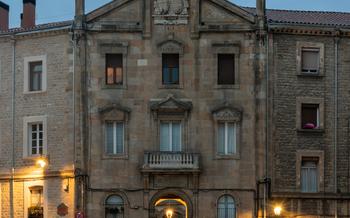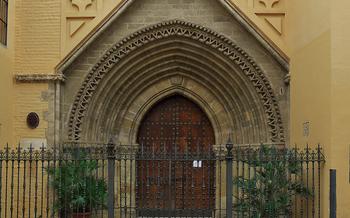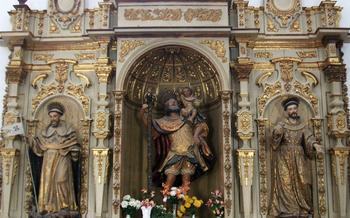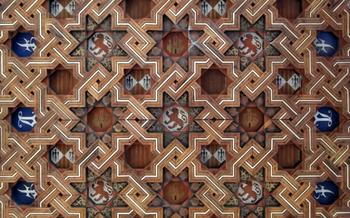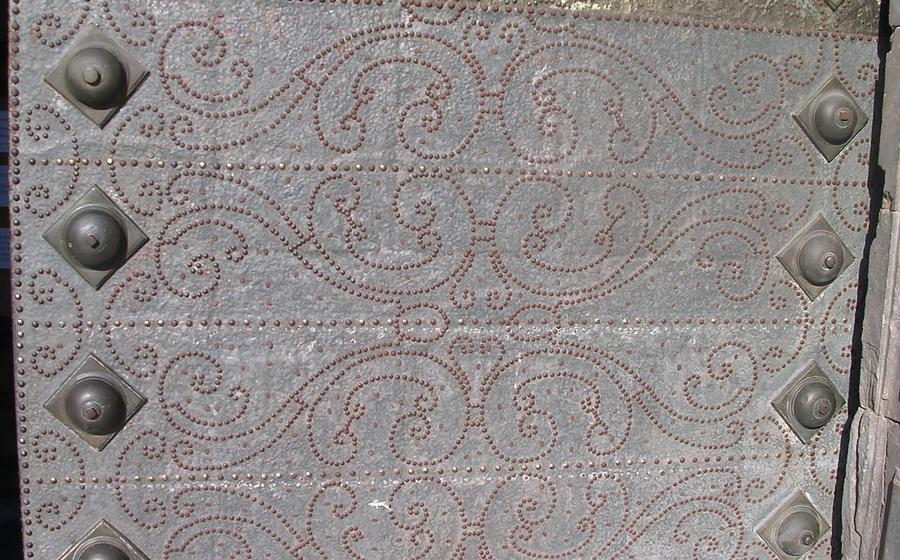
La Santa Espina Sanctuary
- Unveiling the Architectural Masterpiece
- Exploring the Sanctuary's Interior
- A Journey Through Time: The Sanctuary's History
- Discovering the Cloister's Enchanting Gardens
- Immerse Yourself in the Museum's Treasures
- Unforgettable Experiences: Attending Mass at the Sanctuary
- Venture into the Surrounding Natural Landscapes
- Plan Your Pilgrimage or Visit
- Unveiling the Legend of the Virgin of La Espina
- Discover the Sanctuary's Role in the Spanish Civil War
- The Sanctuary's Contribution to the Arts and Culture
- Insider Tip: Enhance Your Experience
Unveiling the Architectural Masterpiece
The La Santa Espina Sanctuary stands as a testament to the harmonious blend of Gothic and Renaissance architectural styles. Its exterior facade, adorned with intricate stone carvings, captivates the eye with its intricate details and delicate ornamentation. Step inside to discover the sanctuary's majestic cloisters, with their graceful arches and serene ambiance. The stunning stained glass windows, shedding vibrant hues of light, add to the awe-inspiring atmosphere of this architectural masterpiece.
Exploring the Sanctuary's Interior
Step inside the sanctuary and prepare to be captivated by its awe-inspiring interior, a testament to the artistry and devotion that went into its creation. Gaze upon the intricate altarpieces, each a masterpiece of craftsmanship, adorned with gold leaf, vibrant colors, and delicate carvings that narrate biblical stories and the lives of saints. Marvel at the exquisite sculptures that grace the walls and niches, capturing the essence of divinity and human emotion in stone. Among these treasures, discover sacred relics, objects of profound religious significance, believed to possess miraculous powers and inspire devotion among the faithful. As you wander through the sanctuary, let the serene atmosphere envelop you, inviting contemplation and a deep connection with the divine.
A Journey Through Time: The Sanctuary's History
The origins of the La Santa Espina Sanctuary can be traced back to the 13th century, coinciding with the Reconquista, when King Alfonso X of Castile granted the land to the Order of Calatrava, a military order entrusted with defending the Christian territories from Muslim rule. The construction of the sanctuary commenced in the 15th century, and the majority of the existing structure dates back to this period.
During the Spanish Civil War (1936-1939), the sanctuary suffered significant damage as a result of anti-clerical violence. Many of its treasures were destroyed or looted, and the sanctuary itself was used as a warehouse and a prison. Fortunately, the sanctuary was largely spared from destruction and was restored to its former glory in the post-war period.
In recent years, significant efforts have been made to preserve and restore the sanctuary. These efforts have included the restoration of the sanctuary's interior, the cloisters, and the gardens. The sanctuary has also been declared a National Monument, ensuring its protection and preservation for future generations.
Discovering the Cloister's Enchanting Gardens
Tucked away amidst the sanctuary's imposing architecture, the cloister's gardens offer a tranquil respite from the grandeur of the stone walls. Step through the arched entrance and be greeted by a serene oasis, where lush greenery and vibrant flowers create a tapestry of natural beauty. Wander along the cobbled paths, past meticulously manicured hedges and hidden corners revealing serene fountains. The gardens are a haven for contemplation and relaxation, inviting visitors to sit beneath the shade of ancient trees, listen to the gentle trickle of water, and immerse themselves in the tranquility of this sacred space.
Immerse Yourself in the Museum's Treasures
Delve into the depths of history and spirituality at the museum located within the sanctuary. This treasure trove houses a remarkable collection of religious artifacts, each telling a unique story about the sanctuary's rich past. From intricately crafted gold and silver chalices to ancient manuscripts adorned with delicate calligraphy, the museum offers a glimpse into the sanctuary's significance as a center of pilgrimage and devotion.
In addition to these precious objects, the museum also showcases historical documents and manuscripts that provide insights into the sanctuary's construction, its role in the Spanish Civil War, and its subsequent restoration. Interactive exhibits bring the sanctuary's history to life, allowing visitors to experience the sights and sounds of this sacred place through multimedia presentations and virtual reality displays.
Unforgettable Experiences: Attending Mass at the Sanctuary
Immerse yourself in the spiritual essence of La Santa Espina Sanctuary by attending a Mass. Witness the devotion of the local community as they gather to celebrate their faith within these sacred walls. Experience the palpable sacred ambiance that fills the air, amplified by the enchanting acoustics of the sanctuary. On certain occasions, Gregorian chant performances elevate the Mass to an ethereal level, transporting attendees to a realm of celestial harmony. Throughout the year, the sanctuary hosts special events and celebrations that draw pilgrims and visitors from afar. These events offer a unique opportunity to witness the deep-rooted traditions and vibrant religious heritage of this special place.
Venture into the Surrounding Natural Landscapes
Beyond the sacred walls of the La Santa Espina Sanctuary, nature unfolds its splendor, inviting pilgrims and visitors alike to explore the breathtaking landscapes that embrace this spiritual haven. Lace up your hiking boots and embark on a journey through scenic countryside trails, where every step unveils a panorama of rolling hills, verdant valleys, and distant peaks. As you ascend the gentle slopes, the sanctuary's majestic silhouette diminishes in the distance, replaced by a tapestry of vibrant colors and textures.
The surrounding mountains provide a dramatic backdrop for your pilgrimage, their rugged peaks piercing the azure sky. Take a moment to pause and marvel at the panoramic vistas, where the sanctuary's spires seem to blend seamlessly with the natural wonders that surround them. This harmonious coexistence of nature and spirituality creates a sense of tranquility and awe that lingers long after your visit.
For the keen-eyed observer, the region offers a haven for wildlife. Keep an eye out for soaring birds of prey, their wings outstretched against the backdrop of the mountains. The gentle slopes are home to a variety of small mammals and reptiles, while the nearby forests shelter a diverse array of flora and fauna. As you wander through this natural paradise, let the tranquility of the surroundings soothe your soul and enhance your pilgrimage experience.
Plan Your Pilgrimage or Visit
Before embarking on your journey to the La Santa Espina Sanctuary, thoughtful planning will ensure a fulfilling experience. The sanctuary welcomes visitors throughout the year, but the best time to visit is during the spring or fall, when the weather is pleasant and the surrounding countryside is at its most vibrant.
Accommodation options in the area range from charming guesthouses to comfortable hotels, catering to different preferences and budgets. It's advisable to book your stay in advance, especially during peak pilgrimage season, to avoid any last-minute surprises.
To make the most of your visit, consider joining a guided tour or pilgrimage service. These tours provide insightful commentary on the sanctuary's history, architecture, and religious significance, enhancing your understanding and appreciation of this sacred site.
Practical information, such as opening hours, admission fees, and dress code, can be found on the sanctuary's official website or by contacting the local tourist office. Remember to dress respectfully when visiting the sanctuary, as it is an active place of worship.
Unveiling the Legend of the Virgin of La Espina
The La Santa Espina Sanctuary holds a captivating legend that has been passed down through generations. According to local lore, the miraculous statue of the Virgin Mary enshrined within the sanctuary was discovered by a shepherd boy in the 13th century. While tending his flock, the boy noticed a strange glow emanating from a thicket of thorns. Upon investigating, he found a beautiful statue of the Virgin Mary hidden among the brambles.
News of the miraculous discovery spread like wildfire, and soon pilgrims from all corners of the region flocked to the site to witness the wonder for themselves. The Virgin Mary, affectionately known as the Virgin of La Espina, became renowned for her healing powers and the numerous miracles attributed to her intercession.
To this day, the legend of the Virgin of La Espina remains deeply intertwined with the identity and devotion of the local community. Annual festivities and processions are held in her honor, drawing thousands of pilgrims and visitors who come to pay homage and seek her blessings.
Discover the Sanctuary's Role in the Spanish Civil War
During the tumultuous years of the Spanish Civil War, the La Santa Espina Sanctuary stood as a beacon of resilience amidst the chaos and destruction. Remarkably, the sanctuary was one of the few religious sites in the region to survive the conflict relatively unscathed, thanks to the efforts of the local community and the intervention of influential figures.
The sanctuary's location in a remote and sparsely populated area played a crucial role in its preservation. Far from the front lines and major battlefields, the sanctuary was spared from direct military confrontation. Moreover, the local villagers formed a protective cordon around the sanctuary, preventing any attempts at desecration or looting.
The sanctuary also served as a refuge for civilians seeking shelter from the violence and atrocities of the war. Its thick walls and secluded location provided a safe haven for those fleeing the horrors of the conflict. Historical accounts and survivor testimonies recount the sanctuary's transformation into a makeshift hospital, where the wounded and sick received care and compassion.
The sanctuary's survival during the Spanish Civil War stands as a testament to the enduring faith and resilience of the local community. It emerged from the conflict as a symbol of hope and renewal, serving as a reminder of the enduring power of spirituality in times of adversity.
The Sanctuary's Contribution to the Arts and Culture
The La Santa Espina Sanctuary has been a cradle of artistic and cultural creation throughout its history. Its sacred spaces have served as a canvas for renowned artists and craftsmen, leaving behind a rich legacy of paintings, sculptures, and architectural marvels. The sanctuary's collection includes masterpieces from various artistic periods, showcasing the evolution of artistic styles and techniques. Restoration and conservation efforts have been instrumental in preserving these treasures, ensuring their continued appreciation by future generations. Furthermore, the sanctuary regularly hosts cultural events and exhibitions, providing a platform for contemporary artists to showcase their works and engage with the local community.
Insider Tip: Enhance Your Experience
To truly immerse yourself in the essence of La Santa Espina Sanctuary, consider attending the annual medieval market, a vibrant celebration that transports visitors back in time. Experience the sights, sounds, and flavors of a bygone era as you wander through stalls showcasing traditional crafts, local produce, and delectable treats. Don't miss the opportunity to savor the region's culinary delights, sampling traditional dishes crafted with fresh, local ingredients and paired with a glass of regional wine. Venture beyond the sanctuary grounds to explore the picturesque surrounding villages, each with its unique charm and hidden gems. Engage with the friendly locals, discover authentic experiences, and immerse yourself in the vibrant culture of this enchanting region.
